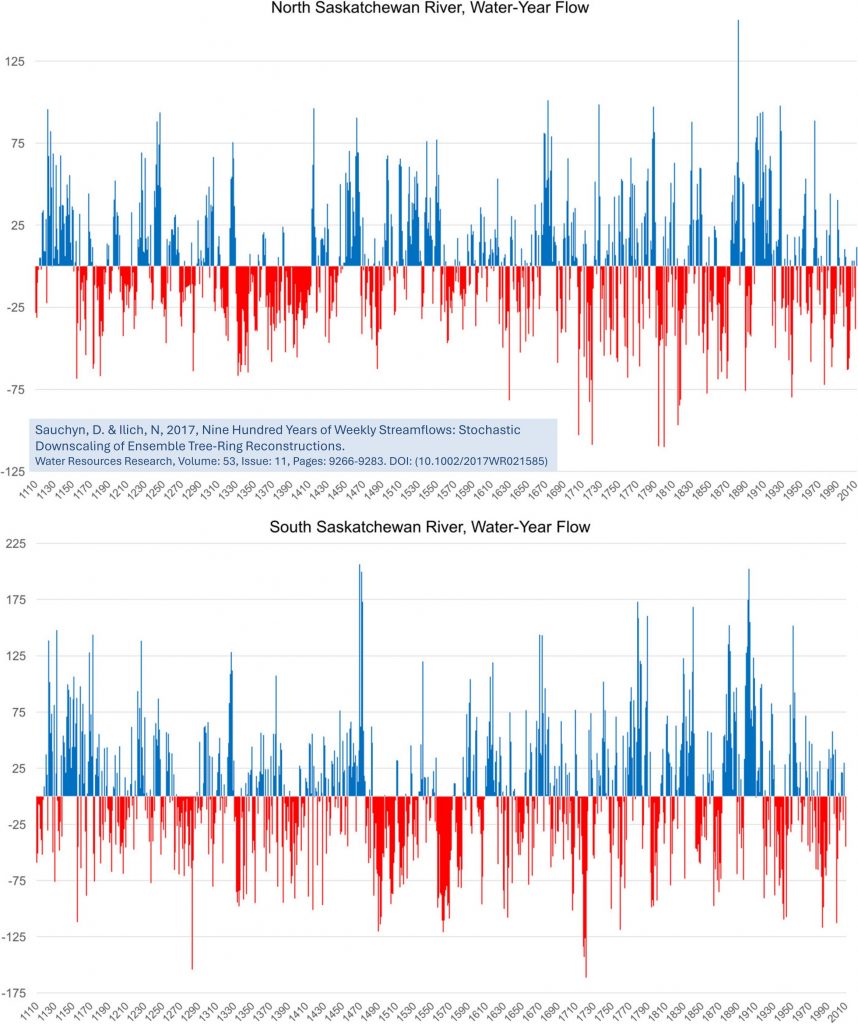History of Drought in Alberta
Drought is no stranger to the Canadian Prairies. In fact, some may say that drought is a defining characteristic of Alberta, Saskatchewan and Manitoba. Drought is something that has occurred regularly over the centuries in this region (for example, over 40 droughts have affected western Canada over the last two centuries). Over the last nine hundred years, the Prairie Provinces have experienced several decadal droughts, several multi-decadal droughts and large floods (see Figure 1).
How do scientists know that droughts occurred centuries before humans started measuring and recording data such as streamflow and precipitation? Although we only have data from river gauges on river flows from the late 1800s and early 1900s, researchers have pushed our understanding of past river flows in the Prairies back to the early 1100s using tree-ring data [1].


Tree ring study and analysis (called dendrochronology) has been used to chart the occurrence of drought (and floods) in centuries before human measurements were taken and recorded. Although tree ring analysis is a complex undertaking, in the simplest terms, narrow rings indicate dry years, and wider rings indicate wetter years.
Climate change is expected to increase the risk of droughts (and floods) events in the coming decades. In the blunt words of the Prairie Provinces Regional Perspectives Report [2], “With climate change, the Prairie provinces are projected to be much less cold than at present, with increased total precipitation, although mostly in winter and spring (Zhang et al., 2019). Evaporation and transpiration will also increase with warmer temperatures, leading to more frequent and intense droughts and soil moisture deficits over the southern Prairies during summer (Cohen et al., 2019).” (p. 11).
The effects of these droughts will vary according to the type of drought. For example, a “meteorological drought”, caused by a lack of rain, is likely to immediately challenge dryland famers. On the other hand, a “hydrological drought”, caused by low water levels as in Alberta in 2023 , is likely to present broader risks to irrigation, industrial and municipal supplies ( [3], p.22).
Most of the information available on drought in the Prairies and its human impact focuses on the time period from the 1700s to present day. We invite readers with a background in pre-settlement history to contact us with information on drought experienced in the region and its impacts on Aboriginal communities so that we can fill this gap.
For more specific information on recent droughts in Alberta, we suggest that you use the links on this page to look at our pages on the 19th Century, 20th Century and 21st Century droughts.
Given the current concern over water supply in western Canada, we will be updating our content more frequently to stay abreast of the situation as it unfolds during 2024.
Sources:
[1] Sauchyn, D. & Ilich, N, 2017, Nine Hundred Years of Weekly Streamflows: Stochastic Downscaling of Ensemble Tree‐Ring Reconstructions. Water Resources Research, Volume: 53, Issue: 11, Pages: 9266-9283. DOI: 10.1002/2017WR021585. Accessed 2024-01-12.
[2] Sauchyn, D., Davidson, D., and Johnston, M., 2020, Prairie Provinces; Chapter 4 in Canada in a Changing Climate: Regional Perspectives Report, (ed.) F.J. Warren, N. Lulham and D.S. Lemmen; Government of Canada, Ottawa, Ontario. https://changingclimate.ca/site/assets/uploads/sites/4/2020/12/Prairie-Provinces-Chapter-%E2%80%93-Regional-Perspectives-Report-1.pdf. Accessed 2024-01-12.
[3] Ibid.
